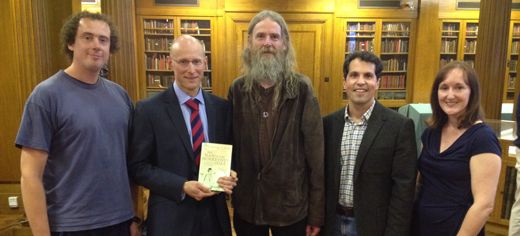
A University of Leeds academic has shed important new light on the fascinating story of a pioneer whose contribution to one of science's biggest discoveries has long been overlooked.
From the late 1920s, University of Leeds biophysicist William T Astbury carried out groundbreaking work using X-rays to study the molecular structure of wool fibres for the West Yorkshire textile industry.
As a result, Professor Astbury helped transform our understanding of biology and made the very first studies of the structure of DNA, so helping to lay the foundations for the 1953 discovery of its double-helical structure by the Cambridge scientists James Watson and Francis Crick. Yet while they went on to win the Nobel Prize, Professor Astbury's name is barely remembered outside Leeds.
Setting Professor Astbury and his work against the wider social and historical backdrop of the time, The Man in the Monkeynut Coat, by Visiting Fellow Kersten Hall, explores the life of this long neglected pioneer.
The book also argues that Professor Astbury’s true scientific legacy extends far beyond DNA. Using the method of X-ray diffraction which had been developed at Leeds a few years earlier by his mentor, Sir William Bragg, Cavendish Professor of Physics at Leeds from 1908-1915, Professor Astbury blazed the trail in using this technique to explore the physical structure of the giant molecules that make up living things.
In doing so, he came to be one of the most prominent evangelists for the new science of molecular biology, which sought to understand life in terms of molecular shapes.
Dr Hall, a molecular biologist and science historian, said: “The discovery of the structure of DNA was without doubt one of the biggest landmarks in the history of science. It transformed our understanding of biology and enabled huge advances in medicine such as the production of new forms of insulin for the treatment of Type 1 diabetes.
“Yet few people realise that the very first attempts to solve the structure of DNA were made right here in Leeds. But as a scientist of international renown, Astbury's legacy went far beyond DNA.
“Molecular biology has had a powerful influence on modern medicine. As a former research fellow in molecular biology here at Leeds, I was fascinated to learn more about the pivotal role that Astbury played in the emergence of this groundbreaking new science.”
Today, molecular biology is at the heart of modern medicine and has given invaluable insights into diseases such as sickle-cell anaemia. It has also given rise to the modern biotechnology industry ¬– a legacy which the book argues can be traced to Professor Astbury and his insight that the shapes of biological molecules might be deliberately altered.
This idea found powerful expression in his rather unusual overcoat, which was woven from monkeynut proteins that had been deliberately manipulated at the molecular level to make them into a textile fibre substitute called Ardil. It was hoped it might prove a cheap alternative to wool; Professor Astbury wore the coat as an example of the power of the new science.
“Like his coat, Astbury is now largely forgotten,” said Dr Hall. “His story is one of both success and disappointment on a grand scale. Despite making the very first studies of the structure of DNA and having a vital clue within his grasp, he never managed to solve the double-helix himself.”
Such was the Professor’s prowess and reputation that Nobel Prize winner Max Perutz referred to the former’s laboratory at Leeds as the “X-ray Vatican”.
But despite these accolades, in the aftermath of the Second World War, Professor Astbury sought Government support to fulfil his dream of establishing Leeds as the national centre for the new science of molecular biology but his plans met with rejection.
Dr Hall said: “Some have suggested that this was such a blow to his spirits he simply gave up the pursuit of DNA, yet this seems to conflict with the image of a man for whom science was always an adventure and who was able to infect his co-workers with a similar excitement and enthusiasm.
“As his colleague and friend Professor Reginald D Preston once wrote: ‘To be with Astbury is like a perpetual Christmas morning’.”
Today, the University of Leeds’ Astbury Centre for Structural Molecular Biology (www.astbury.leeds.ac.uk) stands as a fitting tribute to Professor Astbury and his work. The Centre was founded in 1999 as an interdisciplinary research centre and is today one of the University’s powerhouses of research, aiming to understand life in molecular detail.
But in the words of Professor Preston, Astbury also left “as a monument the whole of molecular biology as a testament of what he had been striving for.”
- The Man in the Monkeynut Coat: William Astbury and the Forgotten Road to the Double-Helix, was published on June 12 by Oxford University Press.
Image information
L-R: Leif Astbury (William T Astbury’s gt grandson); Dr Kersten Hall, Visiting Fellow, University of Leeds; Bill Astbury (William T Astbury’s grandson); Gregory Radick, Professor of History and Philosophy of Science, University of Leeds; Katy Thornton, Head of Special Collections, University of Leeds.
Image credit: University of Leeds
Further information
William Astbury worked at the University of Leeds from 1928 until his death in 1961, when he was Professor of Biomedical Structure.
For further information or to arrange an interview with Dr Kersten Hall, Visiting Fellow in the School of Philosophy, Religion and the History of Science (PRHS), contact Press Officer Gareth Dant on 0113 343 3996 or email g.j.dant@leeds.ac.uk. Images are available from the press office.